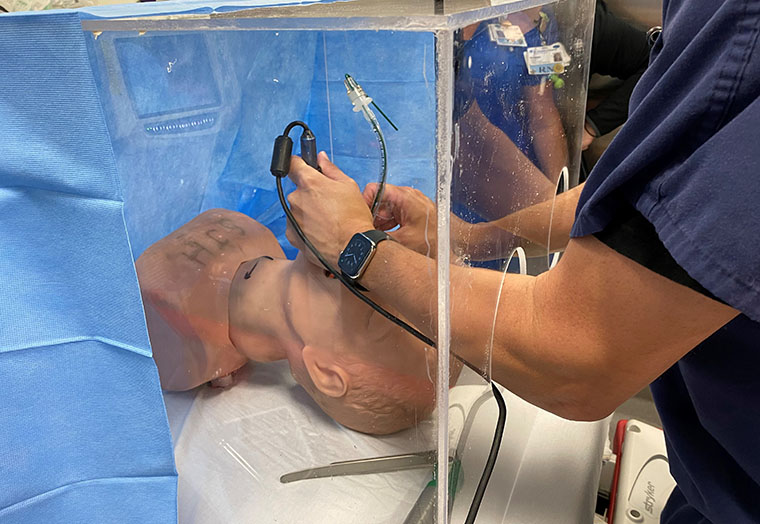BayCare Hospitals Build COVID-19 Apparatus to Protect Health Care Providers

Homemade devices created by two BayCare hospitals to protect health care providers while treating COVID-19 patients are now being mass produced and will be used throughout the system. The devices are used during intubation, the point of highest risk for spread of the virus to health care personnel.
Intubation is the insertion of a tube through the mouth and then into the airway. Intubation is done so a patient can be placed on a ventilator to assist with breathing.
The prototypes, built by both St. Joseph’s Hospital and St. Joseph’s Hospital-South, are plexiglass boxes and were created almost simultaneously in recent weeks. The plexiglass box provides protection to the provider while the patient is supine (lying on their back). The dimensions of the box covers a patient’s head, neck and upper torso. The provider places their hands in two circular cut-outs in the plexiglass. Intubation can involve anesthesiologists, emergency room physicians, ICU physicians or respiratory therapists depending on the stage of the process or the location of the procedure.
The need for the device arose because of a desire to decrease virus particles from spreading throughout the room. Particles can be contained to the box. The box can also protect, preserve and keep clean the personal protective equipment (PPE) worn by providers. PPE includes gowns, masks and face shields.
Dr. Juan Carlos Abanses, a St. Joseph’s Hospital emergency room physician and chair of the hospital’s emergency preparedness committee, and Dr. Alexander Paloma, director of anesthesia at St. Joseph’s-South, both saw the boxes on the Internet. Abanses and Paloma went to work to create prototypes. Neither knew the other was working on a prototype.
“This is an example of the medical community all over the world coming together,” Paloma said. “There was a critical need and we rallied quickly. It was quite beautiful to see the sharing of ideas all over the world. The medical community helps one another out and is not selfish. I’m proud to say I’m a part of it.”
Abanses was assisted with the prototype by St. Joseph’s Hospital team members Christopher Perry, a maintenance technician, and Richard Traina, a carpenter. Paloma was assisted by Andres Santana, anesthesia supervisor at St. Joseph’s Hospital-South and BayCare anesthesiologist Dr. Adam Gorberg. At one point, Perry and Santana both worked on the separate prototypes in their garages. The tools and components are simple – plexiglass, a table saw, clamps and epoxy.
“The level of protection that the box can provide is very good,” Dr. Abanses said. “It prevents secretions from going up into the air and towards the provider. “It effectively can block the virus at the point of greatest risk of the virus floating up into the air and infecting everyone in the room by confining it to the intubation box. And there is no restriction to what the provider has to do with their hands. The provider can maneuver a scope in one hand and a tube in the other.”
One challenge Abanses and Paloma both mentioned was changing the box dimensions to accommodate the size of Americans. Many of the examples they saw on the Internet were designed in Asian countries. Both modified their prototypes for the typical American patient population. They also had to consider the size of the health care provider while customizing their boxes.
The boxes were tested using mannequins and eventually approved for use by BayCare.
Dr. Mark Vaaler, vice president and chief medical officer for St. Joseph’s Hospital-South, St. Joseph’s Hospital-North, South Florida Baptist Hospital and Bartow Regional Medical Center, is overseeing the intubation box project.
He said it was decided to mass produce the boxes so they could be manufactured and distributed quickly to hospitals.
“One very positive outcome from this process is that we are helping a local business keep their staff working,” said Michael Neely, director of facilities management for BayCare’s East Region. “The contractor helping us was able to call back laid off workers to help.”
Vaaler noted the ingenuity and innovation involved in coming up with the prototypes.
“A lot of credit has to go to our innovative clinicians and support staff,” Vaaler said.
In addition, Paloma and Santana are working on a second design for a larger box with a side opening to accommodate a ventilator during operating room procedures.
